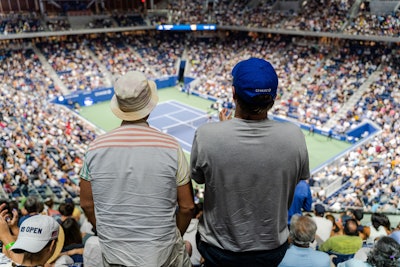
It got so hot and humid Tuesday in Flushing Meadows, N.Y., that U.S. Open officials adopted a new policy for the rest of this year’s Grand Slam event: They will partially shut the Arthur Ashe Stadium roof in extreme conditions to offer extra shade.
As reported by The Associated Press, the temperature climbed above 90 degrees and the humidity topped 50 percent Tuesday, making it the steamiest day of the two-week tournament.
The change to the roof policy was made during Coco Gauff's straight-sets victory over Jelena Ostapenko, when the conditions crossed a threshold for protecting players in the heat, but that match was over too quickly to adjust the retractable cover, tournament referee Jake Garner told The Associated Press.
The new policy is “in the best interest of fans and players,” Garner said.
An AP analysis showed the average high temperatures felt during the U.S. Open and the three other major tennis tournaments have steadily gotten higher and more dangerous in recent decades. For athletes, it can keep them from playing their best and, worse, increases the likelihood of heat-related illness.
The forecast calls for even hotter temperatures in the coming days as the tournament heads toward its Sunday conclusion.
According to the AP's Howard Fendrich, Ashe Stadium was partly closed before Novak Djokovic's 6-1, 6-4, 6-4 win against Taylor Fritz. Djokovic poured water over his head during one changeover, and Fritz removed his shirt and placed a rolled-up towel filled with ice around his neck during another.
Fritz thought having less of an opening above the stadium increased how humid it seemed. “It was definitely hot," he said. "I feel like we played some pretty physical, long points in the beginning of the match. After a couple, it hit me. I’d say it’s more the humidity than anything. I don’t feel like I’m ever bothered too much by the heat. I feel like (when) it’s just really humid ... it just drains you.”
The roof on Louis Armstrong Stadium was shut some of the way after the first set of a women’s doubles quarterfinal, Fendrich reported.
“What went into today was we’re at a point in the tournament where all singles matches are on Ashe, so we felt we could comfortably put into a place a practice that was the same for all singles matches,” Garner said. “As the temperature and the forecast were continuing to rise, we convened and made the decision that for 2023, our policy will be when the heat rule ... comes in, we will partially close the roof at the next set break.”
According to the AP's Fendrich, the heat rule allows for a longer break between sets in singles matches when a reading that takes into account temperature and other facts crosses above 86.2 degrees.
The U.S. Tennis Association said the decision was made by Garner, who said tournament management and medical staff were also involved.
“The immediate impact is specifically that more fans were shaded,” Garner said, “and at the same time, the decision to close the roof puts the court in full shade, which does improve the conditions on court.”





































